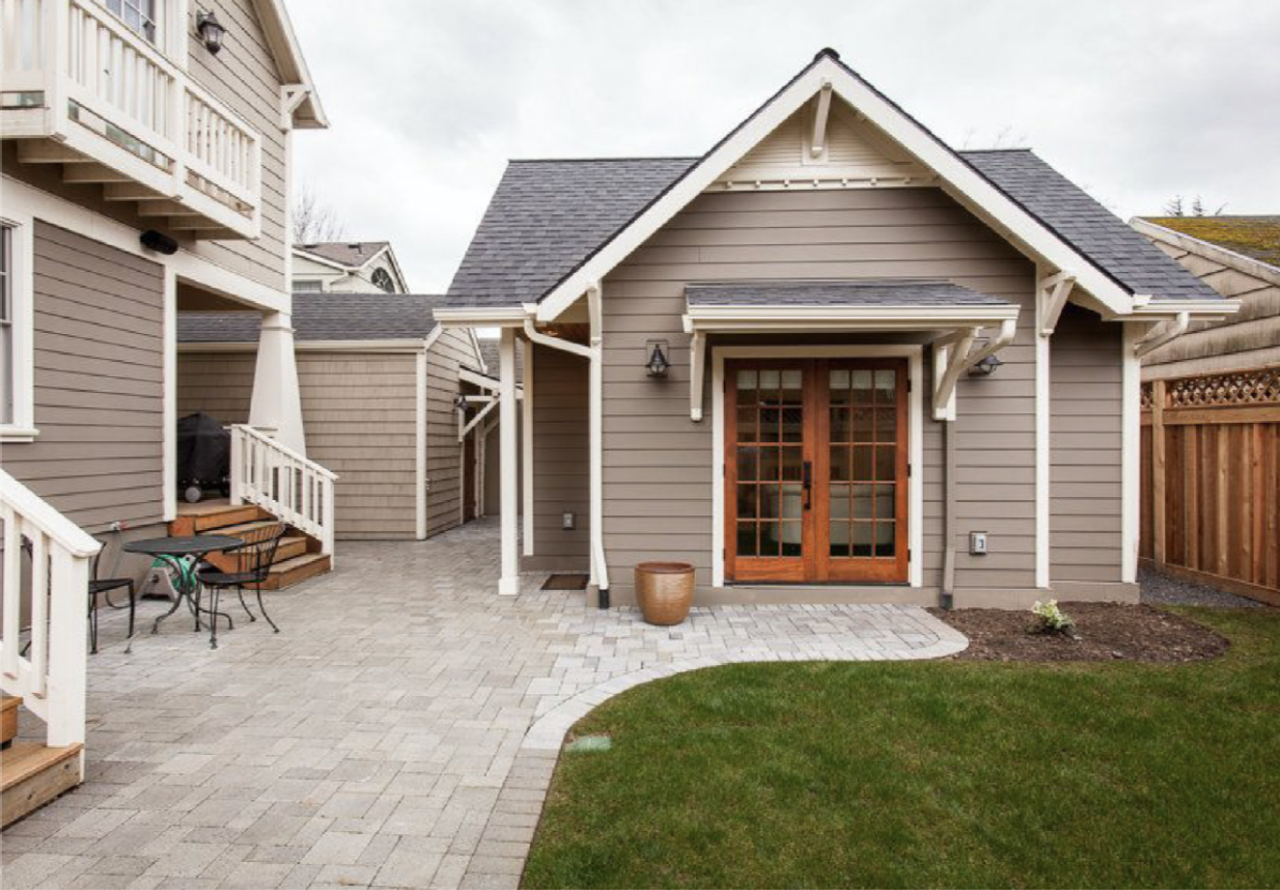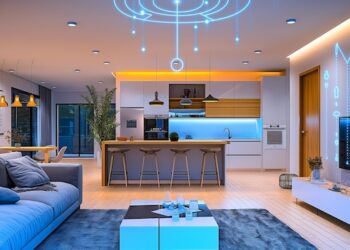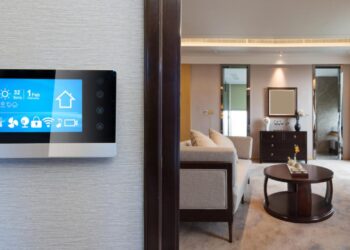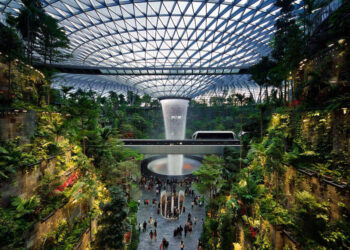Why Homes Become Hubs

The accelerated evolution of dwellings into productive hubs stems from a powerful confluence of technological innovation, socio-economic shifts, and a re-evaluation of how we live and work.
A. Technological Ubiquity and Advancement:
A. High-Speed Connectivity: The widespread availability of robust broadband, Wi-Fi 6, 5G, and fiber optics provides the essential backbone for seamless connectivity, enabling countless smart devices and high-bandwidth activities like video conferencing and cloud computing. This constant, fast connection is the very foundation that allows homes to operate as sophisticated hubs, supporting multiple users and devices simultaneously without lag.
B. Internet of Things (IoT) Proliferation: Smart devices, from lighting and thermostats to appliances and security cameras, are now affordable and commonplace. These devices communicate, collect data, and can be centrally managed, forming an intelligent network within the home. This interconnectedness allows for complex automations and a holistic approach to home management, turning individual gadgets into a cohesive system.
C. Artificial Intelligence (AI) and Machine Learning (ML): AI empowers smart home systems to learn user preferences, anticipate needs, automate routines, and optimize resource usage. ML allows these systems to become more intuitive and personalized over time, moving beyond simple programmed commands to predictive capabilities. Imagine your home pre-cooling itself before you arrive, learning your commuting patterns, or suggesting lighting scenes based on your mood.
D. Advanced Collaboration Tools: Cloud-based platforms, sophisticated video conferencing (like Zoom, Microsoft Teams, Google Meet), digital whiteboards, and project management software have become integral to how we work, learn, and socialize. These technologies enable seamless interaction regardless of physical location, effectively extending the office or classroom into the dwelling.
B. Evolving Work Models and The Gig Economy:
A. Rise of Remote and Hybrid Work: The global shift, accelerated by recent events, has proven the viability and often the benefits of working from home. For many, the “office” is now a flexible concept, blurring traditional geographical and temporal boundaries. This means homes need to be more than just living spaces; they need to function as fully equipped professional environments.
B. Independent Workforce Growth: The expansion of the freelance and gig economy means more individuals operate their businesses directly from home, or use it as their primary base. This requires dedicated, efficient, and professional workspaces within their dwellings, complete with reliable connectivity and ergonomic setups, often adapting quickly to different project demands.
C. Flexible Schedules: Modern work often entails non-traditional hours, with professionals needing to work across time zones or balance personal commitments. Connected homes allow individuals to transition seamlessly between personal and professional tasks, fitting work around life rather than the other way around, providing unprecedented autonomy over their schedules.
C. Demographic Shifts and Lifestyle Demands:
A. Multi-Generational Living: More households now include multiple generations, from young children to elderly parents. This requires homes to accommodate diverse needs for privacy, shared spaces, and specialized functionalities (e.g., dedicated study areas for children, accessible features for seniors, separate living quarters for adults). Smart design can facilitate this coexistence.
B. Smaller Living Spaces: In dense urban areas, apartment and condo living means maximizing every square foot. Connected tech helps multi-purpose rooms adapt for work, leisure, or family gatherings, using transformable furniture and intelligent zoning to make small spaces feel larger and more versatile.
C. Lifelong Learning: The pursuit of new skills, online courses, personal development, and remote education often takes place at home. This necessitates dedicated and well-equipped learning environments that can support concentrated study, virtual classrooms, and access to digital resources.
D. Demand for Convenience and Efficiency: Busy modern lives drive a desire for automation that simplifies routines, saves time, and manages domestic tasks more efficiently. Connected dwellings respond to this by handling mundane chores autonomously, freeing up valuable mental bandwidth for more engaging activities.
D. Focus on Well-being and Sustainability:
A. Holistic Health: There’s a growing understanding that our physical environment directly impacts mental and physical health. Connected dwellings can actively optimize conditions like air quality, lighting (especially natural light), temperature, and even soundscapes to promote well-being, reduce stress, and enhance sleep.
B. Energy Conservation: Smart home systems actively monitor and manage energy consumption, turning off lights in empty rooms, adjusting thermostats based on occupancy, and optimizing appliance use. This leads to significant waste reduction, a smaller carbon footprint, and reduced utility bills.
C. Resource Optimization: Intelligent systems ensure resources like water and power are used only when and where needed, minimizing waste and fostering a more sustainable lifestyle. This includes smart irrigation systems that respond to weather, or leak detection systems that prevent excessive water loss.
The Anatomy of a Productive Hub
Transforming a dwelling into a truly connected and productive hub involves integrating various smart systems and design elements that work in harmony, creating a cohesive and intelligent ecosystem.
A. The Intelligent Core
At the heart of every connected dwelling lies the central intelligence that orchestrates all devices and functionalities, acting as the brain of the home.
A. Smart Hubs and Controllers: Dedicated devices like Amazon Echo (Alexa), Google Nest Hub, Apple HomePod, Samsung SmartThings, Hubitat, or Control4 act as the central brain. They bridge various communication protocols (Wi-Fi, Zigbee, Z-Wave, Thread, Bluetooth) and allow devices from different manufacturers to communicate, creating a unified system from disparate parts.
B. Voice Assistants: Integrated into hubs, smart speakers, smartphones, smart TVs, and even certain appliances, voice assistants provide intuitive, hands-free control. This allows occupants to command their environment naturally, simply by speaking, greatly enhancing convenience.
C. Centralized Apps and Dashboards: Most smart home ecosystems offer intuitive smartphone/tablet applications or dedicated wall-mounted touchscreens that serve as the primary visual interface. These dashboards provide a holistic view for monitoring, managing, and customizing routines, schedules, and device settings across all connected devices from anywhere.
D. AI-Powered Automation Engines: These engines are the true intelligence behind the hub. They learn from user behavior, schedules, and external conditions (weather forecasts, traffic patterns, utility pricing) to automate complex routines (e.g., lights dimming and blinds closing as evening approaches, security systems arming when the last person leaves the house, or adjusting heating based on projected arrival time). They move from reactive commands to proactive, intelligent responses.
B. Optimized Work and Learning Zones
Creating environments within the home that are conducive to sustained focus, creativity, and efficient productivity for professional or educational pursuits.
A. Dedicated Workspaces:
A. Ergonomic Furniture: Essential for long hours, this includes adjustable sit-stand desks, ergonomic chairs that provide proper lumbar support, and monitor arms that allow screens to be positioned at eye level. These support healthy posture, reduce physical strain, and encourage movement.
B. Task-Specific Lighting: Focused, adjustable lighting (e.g., a good desk lamp) that minimizes eye strain for reading, writing, or computer work, complementing ambient room light.
C. Acoustic Management: Critical for minimizing distractions. This involves using sound-absorbing materials (thick rugs, heavy curtains, upholstered furniture), creating quiet zones, or even employing white noise machines to mask external or internal household noises and enhance concentration.
B. Seamless Connectivity:
A. Robust Wi-Fi Mesh Networks: Crucial for uninterrupted video calls, cloud-based applications, and streaming. Mesh systems ensure strong, reliable internet coverage throughout the entire dwelling, eliminating frustrating dead zones.
B. Wired Ethernet Ports: For critical devices like main computers, network-attached storage (NAS), or smart TVs, wired connections offer superior speed, lower latency, and greater reliability, reducing reliance on potentially fluctuating Wi-Fi.
C. Integrated Collaboration Tools: High-quality webcams, microphones, and speakers that are either integrated into workstations or easily connect to central systems, ensuring seamless participation in virtual meetings, online classrooms, and digital presentations.
D. Multi-functional Spaces: Innovative design that allows living rooms, spare bedrooms, or even kitchen areas to adapt. This includes concealed desks (e.g., a Murphy desk that folds into a wall), modular shelving units, or transformable furniture that can easily switch between leisure and productive modes.
C. Enhanced Comfort and Well-being Systems
Prioritizing physical and mental health within the dwelling, making it a true sanctuary that actively contributes to occupant wellness.
A. Intelligent Climate Control:
A. Smart Thermostats: Devices like Nest, Ecobee, or Honeywell Home learn preferences, adjust heating/cooling based on occupancy patterns, external weather forecasts, and can be remotely controlled for pre-cooling or pre-heating before arrival.
B. Smart Vents/Zone Control: Allowing for precise temperature regulation in individual rooms or specific zones within the home, preventing wasted heating/cooling in unoccupied areas and ensuring personalized comfort.
B. Advanced Air Quality Management:
A. Integrated Air Purifiers: Systems that monitor indoor air quality (CO2, VOCs from new furniture or paint, particulate matter like dust and pollen, humidity) and automatically activate purifiers or ventilation when pollutant levels rise, creating a healthier breathing environment.
B. Non-Toxic Materials: A crucial element of preventive health. Using low-VOC paints, glues, furniture, and flooring minimizes harmful off-gassing, which can contribute to respiratory issues and headaches.
C. Circadian Lighting: Smart lighting systems that automatically adjust their color temperature and brightness throughout the day to mimic natural sunlight patterns. Warmer, dimmer light in the mornings and evenings supports melatonin production for better sleep, while brighter, cooler light in the daytime boosts alertness and concentration.
D. Acoustic Comfort: Beyond work zones, using sound-dampening materials (e.g., insulated walls, double-pane windows, heavy drapes, acoustic panels) to reduce external noise pollution from urban environments and create quiet areas for rest, relaxation, or deep thought.
E. Biophilic Elements: Integrating indoor plants, natural materials (wood, stone, linen), and designing for views to nature (even a small balcony garden or a carefully placed window framing a tree) to reduce stress, improve mood, and foster a fundamental connection to the natural world.
The Benefits of Connected Dwellings as Productive Hubs

The transformation of homes into intelligent, multifunctional hubs delivers a compelling array of advantages for residents, extending far beyond simple technological novelty. These benefits contribute to a higher quality of life and greater efficiency.
A. Unprecedented Convenience and Efficiency
A. Automated Routines: Automating daily tasks (e.g., lights turning on at dusk, thermostat adjusting before arrival home, coffee brewing at wake-up time, blinds closing for privacy in the evening) saves significant time, reduces mental load, and streamlines daily life, allowing occupants to focus on more meaningful activities.
B. Remote Management: The ability to control and monitor home systems (security cameras, door locks, climate control, appliances) from anywhere in the world via a smartphone provides unparalleled peace of mind and flexibility, whether it’s checking on pets or ensuring the oven is off.
C. Resource Optimization: Smart systems actively monitor and manage energy and water consumption, automatically adjusting settings based on real-time usage, occupancy, and external conditions. This leads to significant reductions in utility bills and a more efficient, less wasteful household.
D. Time Savings: Automation of chores, optimized workflows for work/learning, and simplified task management free up valuable time that would otherwise be spent on mundane activities, allowing more time for leisure, family, or personal pursuits.
B. Enhanced Productivity and Focus
A. Optimized Work/Learning Environments: Dedicated, ergonomically sound, and distraction-free zones within the home, complete with task lighting and acoustic dampening, support deep focus and sustained productivity for remote work, online learning, or creative endeavors.
B. Seamless Transitions: The ability to quickly and easily transform a living space into a functional workspace (and vice versa) minimizes setup time and mental friction, enabling fluid shifts between professional, educational, and leisure activities.
C. Reduced Cognitive Overload: By automating routine tasks and minimizing visual and auditory clutter, connected homes free up mental energy that would otherwise be spent on managing the environment, allowing occupants to focus on higher-value creative or intellectual pursuits.
D. Improved Collaboration: High-quality integrated technology (webcams, microphones, stable internet) ensures seamless and effective participation in virtual meetings, fostering effective collaboration with remote teams, clients, or classmates.
C. Superior Well-being and Comfort
A. Stress Reduction: Automation, enhanced security, and environments optimized for comfort (e.g., perfect temperature, ideal lighting) reduce daily stressors and anxieties, contributing to lower cortisol levels and a greater sense of calm and relaxation.
B. Better Sleep Quality: Circadian lighting that mimics natural sunlight, quiet zones, and comfortable thermal conditions contribute significantly to more restful and restorative sleep, which is fundamental to overall health.
C. Improved Indoor Health: Advanced air quality management, selection of non-toxic materials, and maximized access to natural light promote physical health, reducing respiratory issues, allergies, and enhancing overall vitality and energy levels.
D. Personalized Comfort: Environments that learn and adapt to individual preferences for light, temperature, humidity, and sound create a truly personalized and comfortable living experience, making the home feel uniquely tailored.
E. Work-Life Balance: The inherent flexibility and integration of functions within a connected dwelling allows individuals to better integrate their professional and personal lives, fostering a healthier balance and reducing feelings of being overwhelmed.
D. Increased Safety and Security
A. Proactive Monitoring: Continuous surveillance via smart cameras, intelligent motion detection, and instant alerts provide comprehensive protection against intruders, or unforeseen hazards like water leaks or smoke, even when occupants are away.
B. Remote Emergency Response: The ability to remotely interact with visitors via video doorbells, grant emergency access to responders, or receive immediate alerts for hazards enhances safety and responsiveness in critical situations.
C. Deterrence: Visible smart security devices, such as cameras, smart doorbells, and automated lighting triggered by motion, act as strong psychological deterrents, significantly reducing the likelihood of incidents.
E. Environmental Sustainability
A. Reduced Carbon Footprint: Optimized energy and water use through smart management directly contributes to lower greenhouse gas emissions and a more environmentally sustainable lifestyle.
B. Mindful Resource Management: Automated systems prevent waste (e.g., turning off lights in empty rooms, adjusting irrigation based on rainfall), ensuring resources are used efficiently and only when needed.
C. Integration with Renewables: Seamless management of energy flow from rooftop solar panels and home battery storage systems further promotes energy independence, reduces reliance on fossil fuels, and can even allow homeowners to sell excess energy back to the grid.
F. Enhanced Property Value and Future-Proofing
A. Increased Market Appeal: Homes equipped with integrated smart technologies are highly desirable to modern buyers and renters, perceiving them as more advanced, convenient, and efficient, which often commands higher market value.
B. Adaptability to Future Needs: The modularity, scalability, and flexibility inherent in smart home systems allow dwellings to easily adapt to evolving technological standards, changing family dynamics, and future work models without costly, disruptive renovations.
C. Cost Savings Over Time: While initial investment exists, long-term savings on utilities, potentially lower insurance premiums (due to enhanced security features), and higher resale value contribute to a strong overall return on investment for homeowners.
Challenges and Considerations for Connected Dwellings
While the benefits are compelling, realizing the full potential of connected dwellings as productive hubs requires navigating several important challenges that affect adoption, security, and user experience.
A. Data Privacy and Cybersecurity Risks: The extensive collection of personal data (daily habits, voice commands, video feeds, energy consumption patterns) by smart devices raises significant privacy concerns. Poorly secured devices or inadequate software updates can also become vulnerable entry points for cyberattacks, making robust encryption, secure data storage practices, and diligent software maintenance critical.
B. Interoperability and Fragmentation: Despite efforts by industry giants and new, unifying standards like Matter and Thread, the smart home market can still be fragmented. Devices from different manufacturers may not always communicate seamlessly, leading to complex setups, limited functionality, or reliance on multiple apps and hubs.
C. Complexity of Installation and Management: While voice control is intuitive for daily use, setting up, configuring, and troubleshooting a comprehensive smart home ecosystem can be daunting for non-tech-savvy users. This necessitates intuitive user interfaces, reliable customer support, clear instructional guides, or the option for professional installation.
D. Initial Investment and Obsolescence: Building a fully integrated, high-end tech dwelling can involve a significant upfront investment in devices, infrastructure, and installation. Furthermore, the rapid pace of technological change means individual devices can become obsolete quickly, requiring ongoing upgrades, software support, and potentially leading to electronic waste.
E. Reliance on Internet Connectivity: Many advanced smart home features are heavily dependent on a stable, high-speed internet connection. Outages can render sophisticated systems inoperable, reducing “smart” devices to “dumb” ones, and disrupting work or security functions.
F. User Adoption and Behavioral Change: Even with advanced technology, successful integration relies on users adopting new habits and consistently utilizing the features effectively. Resistance to change, a steep learning curve, or a “set it and forget it” mentality can limit the full realization of benefits.
G. Ethical Considerations: As homes become more intelligent, ethical questions arise concerning surveillance within the home, potential algorithmic bias in personalized systems, the long-term impact of constant connectivity on human autonomy, and the digital divide.
H. Power Resiliency: While many smart devices offer battery backups, a complete home automation system can be heavily reliant on continuous power. Designing for power resiliency (e.g., UPS for hubs, integration with home battery storage) is crucial.
Conclusion
The transformation of connected dwellings into productive hubs is a profound testament to our evolving relationship with technology and our innate desire for spaces that enhance our lives. By creating environments that are intelligent, responsive, and deeply integrated, we are not just building smarter homes; we are crafting dynamic ecosystems that empower individuals, foster well-being, maximize efficiency, and lay the groundwork for a more sustainable and fulfilling future. This is the ultimate convergence, where the intimacy of home meets the power of a cutting-edge command center, redefining what it means to live in the modern age.









